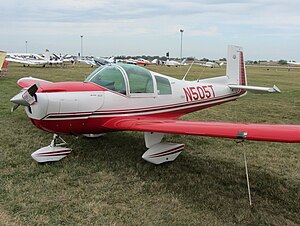
Summary
The Mooney M10 Cadet is a light airplane manufactured by the Mooney Aircraft Company in 1969 and 1970. The M10 is derived from the ERCO Ercoupe, the type certificates for which Mooney purchased from the Alon Corporation in 1967.[1]
| M10 | |
|---|---|

| |
| 1970 Mooney M10 | |
| Role | Single-engine trainer |
| Manufacturer | Mooney |
| Designer | Mooney |
| First flight | 23 February 1968[1] |
| Number built | 59[2] |
| Developed from | ERCO Ercoupe |
Design edit
The M10 is similar to the Alon A2-A, and indeed a handful of "Mooney A2-As" were built in Kerrville in 1968 before changeover of Mooney's production line was completed.[3] According to the FAA Type Certificate Data Sheet,[4] the "Model 10 is similar to Model A2-A except for new design empennage, ailerons and fuel tank vent." The most obvious difference is that the M10 replaces the iconic Ercoupe-style dual vertical stabilizer with a tail designed to allow the airplane to spin. Changes to the ailerons, along with replacement of the A2-A's tail, were motivated by Mooney's intent to market the M10 as a trainer: student pilots receiving training in a non-spinnable airplane, as the Ercoupe was, were issued FAA pilot certificates carrying the restriction that they could only fly airplanes which were "characteristically incapable of spinning"; thus the spinnable tail was necessary to turn the A2-A into a general-purpose trainer. Given that they were replacing the tail, Mooney's engineers opted to give it the "backward" profile characteristic of the M20 series. Although the M10's empennage has the same silhouette as the "big Mooneys", it does not swivel the way the M20's does; the Cadet's tail is a conventional design with fixed horizontal stabilizer, hinged elevator, and trim tabs.
The two type certificates that cover all Ercoupe variants, including the Mooney M10, are currently owned by Univair Aircraft Corporation, in Aurora, Colorado, USA.
Specifications edit
Data from Jane's All the World's Aircraft 1969–70[5]
General characteristics
- Crew: Two
- Length: 20 ft 8 in (6.30 m)
- Wingspan: 30 ft 0 in (9.14 m)
- Height: 7 ft 8 in (2.34 m)
- Wing area: 142.6 sq ft (13.25 m2)
- Aspect ratio: 6.31:1
- Airfoil: NACA 43013
- Empty weight: 950 lb (431 kg)
- Max takeoff weight: 1,450 lb (658 kg)
- Fuel capacity: 24 US gal (20 imp gal; 91 L)
- Powerplant: 1 × Continental C-90-16F air-cooled flat-four engine, 90 hp (67 kW)
- Propellers: 2-bladed McCauley 7153 metal fixed-pitch propeller, 5 ft 11 in (1.80 m) diameter
Performance
- Maximum speed: 103 kn (118 mph, 190 km/h)
- Stall speed: 40 kn (46 mph, 74 km/h) IAS
- Never exceed speed: 125 kn (144 mph, 232 km/h) IAS[4]
- Range: 486 nmi (559 mi, 895 km)
- Service ceiling: 15,500 ft (4,700 m)
- Rate of climb: 835 ft/min (4.24 m/s)
See also edit
References edit
- ^ a b "Mid-Atlantic Air Museum - ERCO/SANDERS 415-G "ERCOUPE" Virtual Tour". Retrieved 2007-01-30.
- ^ "Mooney Model Chronology". Retrieved 2007-01-30.
- ^ "Ercoupe models". Archived from the original on 2010-08-25. Retrieved 2010-08-13.
- ^ a b "Type Certificate Data Sheet No. A-787, Revision 33" (PDF). Federal Aviation Administration. July 14, 2005. Retrieved December 13, 2020.
- ^ Taylor 1969, pp. 389–390
- Taylor, John W. R., ed. (1969). Jane's All the World's Aircraft 1969–70. London: Sampson Low, Marston & Co., Ltd. ISBN 0-354-000-519.
External links edit
- An article on flying the M-10
- Univair Aircraft Corporation


